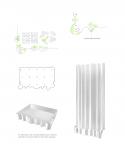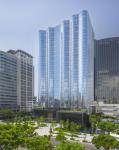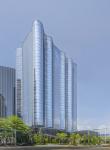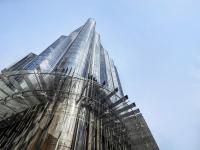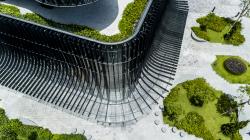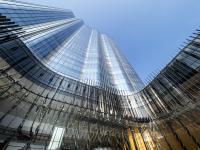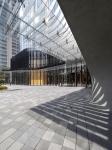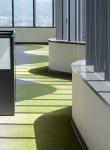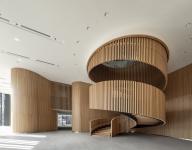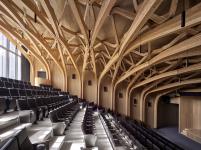For Winbond Corporation, one of the largest tech companies from Taiwan, the Zhubei building is designed to reflect the client’s core value of fostering well being for workers, and commitment to ecological preservation and education. The design goal was to provide a green Gold Energy listed (the second highest energy designation in Taiwan), people-centric work space for collaboration and sharing while working within the uniform efficiency of cubicles that accommodates the legions of high tech workers occupying 19 floors of offices.
The concept of Green Pockets as places for physical and mental recharge becomes the driving force for the architecture. Green Pockets are places for physical and mental recharge, refuge areas of greenery for resting, mingling, brainstorming and informal meetings away from the uniformity and long hours spent at the cubicles. Vertically stacked, these Green Pockets become large scale “flutings” on the tower and form the wavy design of the Tower of Green Pockets.
The form concept produced great environmental benefits upon solar heat gain analysis. Unlike large, flat, south facing curtain wall surface which would get constant direct solar exposure throughout the day, the wavy flutes of the tower create vertical shadow zones that glides across the tower’s elevation throughout the day in the exceedingly hot summers. In the winter, the wavy folds become favorable heat traps. The temperature of the curtain wall thus stays cool in the summer and warm in the winter.
The tower houses a dining floor with garden patio, a gym and a yoga studio. On the ground floor, there is a cafe and an exhibition gallery dedicated to environmental awareness and ecological preservation. Extending the architecture concept, wood is used extensively throughout the lobby. The 8m tall main lobby wall is clad in wood panels along the entire 90m length. A spiral stairs 6.8m in diameter connects the lobby to the meeting rooms on the second floor and the dining hall and garden on the third floor. A unique wood screen design that is created by vertical batons structurally interlocked with wooden blocks becomes the design language for railings and partition screens.
The auditorium juts off the ground floor to create an urban patio underneath. To reflect the client’s on-going support of art and culture, the auditorium showcases a unique wooden roof structure, based on the traditional Chinese dougong which is a stacked and cantilevered timber structure. The modernized dougong is crafted from engineered wood, which allows the dougong members to lift and cantilever at a diagonal to form a spacious diamond lattice of modular 8-point stars. The structure is visible from the street via a window wall at the top of the auditorium. The warm wood color on the entire ground floor gives a strong and continuous visual identity from the street.
2015
2020
Architect: XRANGE Architects
Location: Zhubei City, Hsinchu County, Taiwan
Program Function: Office Building
Site Area: 5,000㎡
Floor Area: 43,000㎡
No. of Floors: 19F
Design: 2015- 2016
Construction: 2016- 2019
Photo Credit: Kuo-Min Lee, Lorenzo Pierucci Studio
Collaborators: JJP Architects & Planners
Building Design: XRANGE Architects, JJP Architects & Planners
Landscape Design: XRANGE Architects, JJP Architects & Planners
Structural Engineers: Envision Engineering Consultant
Lighting Design: Unolai Lighting Design & Associates
Wood Structure: Te Feng Lumber Co., Ltd
Construction Co.: TASA Construction Corporation
Interior Construction: L&L Interiors Inc, TASA Construction Corporation
Curtain Wall: Mega Facade Corporation
Electrical & Plumbing Engineering: Continental Engineering Corporation
Fire System Engineering: Continental Engineering Corporation
Air Conditioning Engineering: Continental Engineering Corporation


